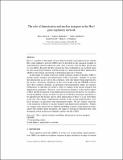Files in this item
The role of dimerisation and nuclear transport in the Hes1 gene regulatory network
Item metadata
| dc.contributor.author | Sturrock, Marc | |
| dc.contributor.author | Hellander, Andreas | |
| dc.contributor.author | Aldakheel, Sahar | |
| dc.contributor.author | Petzold, Linda | |
| dc.contributor.author | Chaplain, Mark A. J. | |
| dc.date.accessioned | 2016-03-22T15:00:08Z | |
| dc.date.available | 2016-03-22T15:00:08Z | |
| dc.date.issued | 2014-04 | |
| dc.identifier | 206440858 | |
| dc.identifier | 6fd2f286-e7cf-460c-afdc-8ce19e1a5f3a | |
| dc.identifier | 84899544543 | |
| dc.identifier.citation | Sturrock , M , Hellander , A , Aldakheel , S , Petzold , L & Chaplain , M A J 2014 , ' The role of dimerisation and nuclear transport in the Hes1 gene regulatory network ' , Bulletin of Mathematical Biology , vol. 76 , no. 4 , pp. 766-798 . https://doi.org/10.1007/s11538-013-9842-5 | en |
| dc.identifier.issn | 0092-8240 | |
| dc.identifier.other | RIS: urn:B2A740A77C03E383290B8BB4F4FD7382 | |
| dc.identifier.other | ORCID: /0000-0001-5727-2160/work/55379011 | |
| dc.identifier.uri | https://hdl.handle.net/10023/8458 | |
| dc.description.abstract | Hes1 is a member of the family of basic helix-loop-helix transcription factors and the Hes1 gene regulatory network (GRN) may be described as the canonical example of transcriptional control in eukaryotic cells, since it involves only the Hes1 protein and its own mRNA. Recently, the Hes1 protein has been established as an excellent target for an anti-cancer drug treatment, with the design of a small molecule Hes1 dimerisation inhibitor representing a promising if challenging approach to therapy. In this paper, we extend a previous spatial stochastic model of the Hes1 GRN to include nuclear transport and dimerisation of Hes1 monomers. Initially, we assume that dimerisation occurs only in the cytoplasm, with only dimers being imported into the nucleus. Stochastic simulations of this novel model using the URDME software show that oscillatory dynamics in agreement with experimental studies are retained. Furthermore, we find that our model is robust to changes in the nuclear transport and dimerisation parameters. However, since the precise dynamics of the nuclear import of Hes1 and the localisation of the dimerisation reaction are not known, we consider a second modelling scenario in which we allow for both Hes1 monomers and dimers to be imported into the nucleus, and we allow dimerisation of Hes1 to occur everywhere in the cell. Once again, computational solutions of this second model produce oscillatory dynamics in agreement with experimental studies. We also explore sensitivity of the numerical solutions to nuclear transport and dimerisation parameters. Finally, we compare and contrast the two different modelling scenarios using numerical experiments that simulate dimer disruption, and suggest a biological experiment that could distinguish which model more faithfully captures the Hes1 GRN. | |
| dc.format.extent | 33 | |
| dc.format.extent | 561094 | |
| dc.language.iso | eng | |
| dc.relation.ispartof | Bulletin of Mathematical Biology | en |
| dc.subject | Hes1 | en |
| dc.subject | Spatial stochastic modelling | en |
| dc.subject | Dimerisation | en |
| dc.subject | Nuclear transport | en |
| dc.subject | URDME | en |
| dc.subject | QH301 Biology | en |
| dc.subject | QA Mathematics | en |
| dc.subject | SDG 3 - Good Health and Well-being | en |
| dc.subject.lcc | QH301 | en |
| dc.subject.lcc | QA | en |
| dc.title | The role of dimerisation and nuclear transport in the Hes1 gene regulatory network | en |
| dc.type | Journal article | en |
| dc.contributor.institution | University of St Andrews.Applied Mathematics | en |
| dc.identifier.doi | 10.1007/s11538-013-9842-5 | |
| dc.description.status | Peer reviewed | en |
This item appears in the following Collection(s)
Items in the St Andrews Research Repository are protected by copyright, with all rights reserved, unless otherwise indicated.

